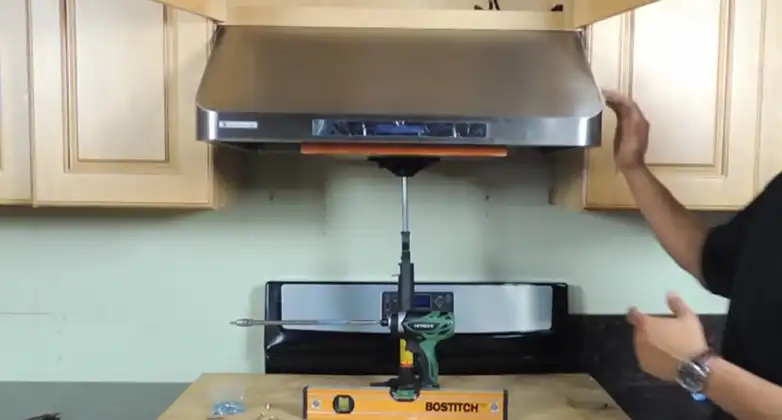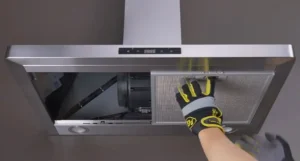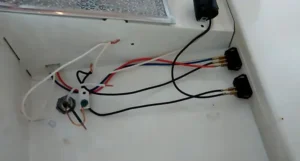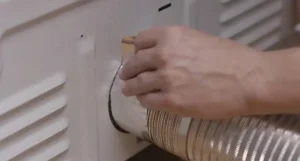Installing an under-cabinet range hood can significantly improve the functionality and aesthetics of your kitchen. Properly positioning the electrical outlet for your range hood is a crucial aspect of the installation process.
However, you can install the outlet for an under-cabinet range hood inside the upper cabinet, near the hood’s power source, hidden from view.
Below, we will discuss the importance of outlet placement, the various factors that can affect it, and safety measures, and provide a step-by-step walkthrough to ensure you’ve done it correctly.

Why Outlet Placement Matters
Before we dive into the specifics of outlet placement, let’s understand why it matters:
Safety
Safety is the most important thing when dealing with electrical installations. Incorrectly placed outlets can lead to exposed wires, tripping hazards, and, in a kitchen environment, the risk of electrical shocks due to proximity to water sources.
Functionality
The convenience of using your range hood depends on the outlet’s location. An inconveniently placed outlet may necessitate the use of extension cords, which can be unsightly and pose additional hazards.
Aesthetics
A well-placed outlet can enhance the overall aesthetics of your kitchen. Concealing the outlet behind the range hood or within a cabinet contributes to a cleaner, more appealing look.
Where to Put Outlet for Range Hood Under Cabinet?
To determine the ideal location for your range hood outlet, consider the following guidelines:
Height
Approximately 18 inches (45 centimeters) above the countertop is a standard height.
Concealment concealing the outlet behind the range hood or cabinet is preferred for aesthetics.
Accessibility
Ensure the outlet is within easy reach of the range hood cord without excessive tension.
Distance from Water Sources, keep the outlet away from water sources, especially the sink.
Compliance
Adhere to local electrical codes and regulations to ensure safety and legal compliance.
How to Ensure Correct Outlet Placement for Range Hood?
Now, let’s outline the steps to ensure you’ve placed the outlet for your under-cabinet range hood correctly:
Step 1: Consult Local Electrical Codes
Start by consulting your local electrical code. This step is crucial for understanding the specific requirements and regulations that apply to your area. Electrical codes can vary significantly, so it’s essential to ensure compliance.
Step 2: Measure and Mark the Location
Once you’ve familiarized yourself with the local electrical code, measure and mark the location for the outlet. Use a tape measure and a level to ensure accurate placement. Make sure it aligns with the height and distance guidelines mentioned earlier.
Step 3: Check Cord Length
Examine the cord length of your range hood. Ensure that the outlet location allows the cord to reach without stretching or causing tension. If the cord is too short, consider having it professionally extended to avoid compromising safety or aesthetics.
Step 4: Test the Outlet
After the outlet is installed, it’s crucial to test it. Use a plug tester or plug in your range hood to verify that the outlet is functioning correctly. Ensure that there are no loose connections or exposed wires.
Precautions and Safety Measures
Now, let’s explore the precautions and safety measures you should consider when placing an outlet for your under-cabinet range hood:
Outlet Height
The standard height for installing an outlet for a range hood is approximately 18 inches (45 centimeters) above the countertop. This height strikes a balance between accessibility and safety. It ensures that the outlet is within reach without being too low to encounter water sources or spills.
Distance from Sink
If your range is located near the sink, it’s essential to maintain a safe distance between the outlet and the sink to prevent potential electrical shock hazards. A common guideline is to keep the outlet at least 36 inches horizontally away from the edge of the sink.
Concealment
Consider concealing the outlet behind the range hood or within a nearby cabinet. This not only enhances the aesthetics of your kitchen but also minimizes the visibility of the outlet, creating a cleaner look.
GFCI Protection
Check whether your local electrical code requires Ground Fault Circuit Interrupter (GFCI) protection for the range hood outlet. GFCI outlets are designed to trip and cut power in the event of a ground fault, providing an extra layer of safety, particularly in areas prone to moisture.
Dedicated Circuit
For optimal safety and performance, it’s advisable to have a dedicated circuit for your range hood. This means that the outlet should not share the circuit with other high-power appliances. A dedicated circuit prevents overloading and ensures consistent power supply to the range hood.
Frequently Asked Questions (FAQ)
Can I install the outlet lower or higher than 18 inches above the countertop?
While 18 inches is a common standard, some flexibility is possible depending on your specific needs and local code requirements. However, always prioritize safety and accessibility.
What is a dedicated circuit, and why is it important for a range hood?
A dedicated circuit means that the outlet is on its electrical circuit separate from other appliances. It’s essential for preventing circuit overloads and ensuring the reliable operation of your range hood.
Can I perform the outlet installation myself, or should I hire a professional?
While it’s possible to perform the installation yourself if you have electrical expertise, it’s strongly recommended to hire a licensed electrician if you have any doubts or concerns about the process. Safety should be the top priority.
To Sum it Up
Properly placing the electrical outlet for your under-cabinet range hood is a critical aspect of kitchen safety and functionality. By adhering to local electrical codes, following recommended guidelines, and considering factors like kitchen layout and range hood model, you can ensure that your outlet placement enhances both the safety and aesthetics of your kitchen. Always prioritize safety, and when in doubt, consult with a licensed electrician to ensure a safe and compliant installation.



